Ceramics

The ceramic sector in India is about 100 years old. It mostly comprises of ceramic tiles, sanitary ware and crockery items. Ceramic products are manufactured both in large and small-scale sectors with wide variations in type, size, quality, and standard. Though there are many large companies in the ceramic sector, small and medium enterprises (SMEs) account for more than 50% of the total market in India. Today, SME players in the ceramic sector face challenges resulting from rising energy costs, environmental concerns, and competitiveness. Adopting EE technologies curtails energy costs, thereby reducing production costs and increasing competitiveness. The project is helping the manufacturing units in adopting EE technologies and practices to advance towards a more sustainable future.
Clusters
Thangadh Ceramic Cluster profile
Overview of Cluster
Thangadh is a large ceramic cluster located in Gujarat close to Rajkot. The cluster is engaged in the production of sanitary wares. The basic raw material, fire clay, is locally available. Most of the wall and floor tile units established earlier in the cluster have now closed down but the sanitary-ware and refractory units are flourishing
Cluster Size and turnover
There are about 225 ceramic units operating in the cluster engaged in the production of sanitary- ware, and refractory.
The capacity-wise distribution of Thangarh ceramic units is shown in the table below. Some of the large units in the cluster are Anchor Sanitary wares, Deep Ceramic, Porous Tiles, Sunrise Pottery Works, Choice Sanitary Ware Industries, Top Anchor Industries, Choice Traders and Ariston Ceramic. The annual turnover of the cluster is about Rs 150 crores. The cluster provides direct employment to 15,000 people
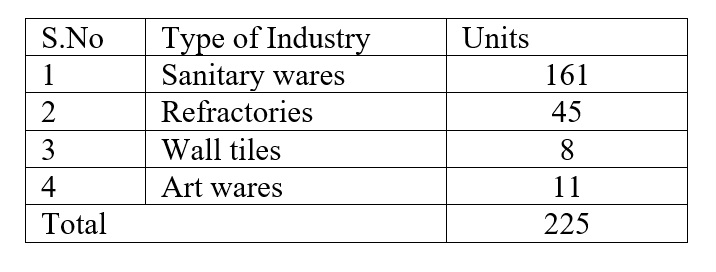
Process flow
Manufacturing of ceramic item uses wide range of raw material combination to produce different shape, size and colour. It requires both electrical and thermal energy at different stages of the process to operate the ball mill, casting/moulding, kilns, cutting & finishing machines and utilities such as motors, pumps air compressor etc. Ceramic manufacturing process primarily consists of mould preparation, body material preparation, shaping, drying and firing.
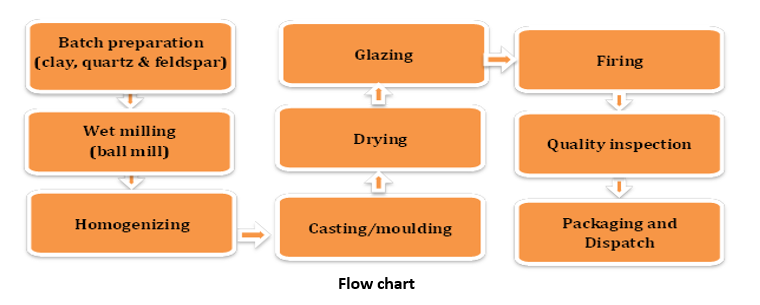
Technology status and energy use
Kiln is widely used for production in different ceramic units. Natural Gas (NG) and charcoal are widely used as fuel in the kilns. With the availability of NG in the last few years, all most all the units have already switched over to NG firing

GEF-UNIDO-BEE Project Impact in the cluster
The project through it various measures has created a real impact on Energy Efficiency in the cluster. Some of the initiatives are as follows: :
- Capacity building workshops for enterprises and local service providers.
- Energy measurement centres.
- Detailed energy audits.
- Identification of technology on Energy Efficiency.
- Financial assistance for demonstration projects.
Morbi Ceramic Cluster profile
Overview of Cluster
Morbi is located in Rajkot district of Gujarat. It lies at a distance of 200 km from Ahmedabad
and 65 km from Rajkot. The Morbi ceramic cluster houses more than 6107
units and has a
cumulative industrial investment of over INR 8,000 crore. The industrial area produces Wall
Tiles, Floor Tiles, Vitrified Tiles, Polished Glazed Vitrified Tiles, Twin Charged Tiles, Multi-colour
Charged Tiles in various formats starting from 20 x 30 cm to 120 x 180 cm in a wide range of
designs and colors. It also produces sanitary ware, industrial ceramics and technical ceramic
products. It is the 2nd largest ceramic tiles producing cluster in the world and accounts for
more than 90% of total ceramic production in India. The ceramic units in Morbi uses latest
technologies and equipment imported from all over the world.
Unorganized tile manufacturers hold more than 50% of the tile manufacturing capacity and
supplies significant quantity to organized players in India. Units in Morbi are exporting to
countries like Middle East, Sri Lanka, Bangladesh, Africa, etc.
Clay, the most important material required for manufacturing ceramic tiles, is generally
obtained from Rajasthan in India and other parts of Gujarat.
The various types of kilns operational in Morbi are generally tunnel kilns for sanitaryware and
roller kilns for ceramic tiles. The roller kilns used for manufacturing tiles have computer-based
firing control where the temperature profile is preset. On the other hand, the tunnel kilns have
manual control.
The ceramic tile units in the Morbi cluster were earlier using either natural gas or gasification
units (which burn coal to generate gas). With NGT’s order in March 2019 to discontinue usage
of all type of coal gasifiers considering its adverse impact on the environment, all the units
have mandatorily switched to PNG for their fuel requirements. The ceramic tile units in the
Morbi cluster now uses natural gas for roller kiln and coal for spray dryer. Other electrical
energy consuming equipment in tiles manufacturing units are ball mills, spray dryer, press
machine, pumps, compressors, etc.
There are four associations in Morbi providing various supports to the ceramic units for
improving the product quality and energy efficiency – Vitrified Tiles Division, Wall Tiles Division,
Floor Tiles Division and Sanitaryware Division.
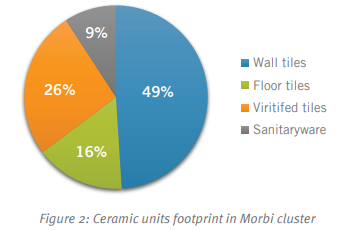
There are five main industry associations active in Morbi cluster: :
- Gujarat Ceramic Floor Tiles Manufacturers’ Association;
- Morbi Sanitary Wares Manufacturers Association;
- Morbi Dhuva Glaze Tiles Association;
- Vitrified Floor Tiles Association
- Roofing Tiles Association
Technology status and energy use
The ceramic units use roller kilns for tile manufacturing and tunnel kilns for the production of sanitary ware. Natural gas (NG), charcoal, and lignite are used as fuel in the firing process. More than half of the thermal energy requirement is met through NG. Charcoal and lignite are mainly used in spray dryers. Energy cost comprises 30–35% of the total production cost. The specific energy consumption (SEC) of ceramic units varies widely with the type of product and processes used. The SEC of a vitrified tile unit ranges between 6.0 and 8.9 GJ/tonne; that of a wall/ floor tile unit varies between 4.8 and 8.8 GJ/tonne; while the corresponding range for a sanitary ware unit is 3.1–4.4 GJ/tonne. It may be noted that many of the small and medium units meet part of their raw material requirement from spray-dried mud manufacturing units operating in the cluster. The main energy consuming processes in tile and sanitary ware units, and the forms of energy used, are listed below:

Morbi is one of the 29 clusters covered under the BEE- SME program, which aims at accelerating the adoption of energy-efficient technology and practices in select clusters. It is also one of the clusters included under the UNIDO-GEF project. Morbi offers potential for various energy-saving options in both thermal and electrical areas. These would help in reducing the energy consumption of the cluster by about 150,000 tonnes of oil equivalent (toe) and CO2 reduction of 0.44 million tonnes.
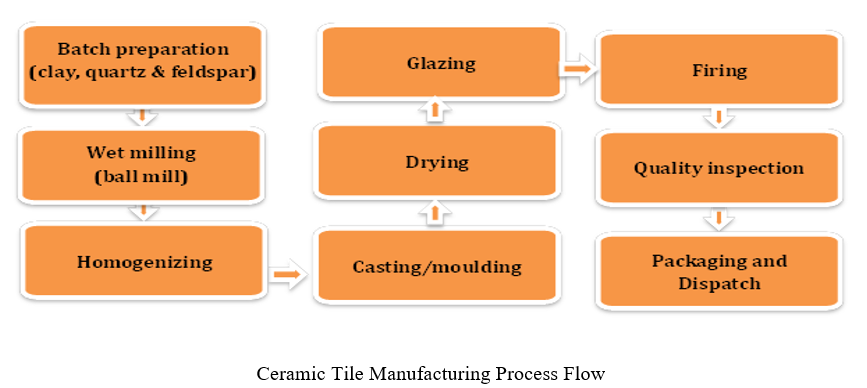
GEF-UNIDO-BEE Project Impact in the cluster
The project through it various measures has created a real impact on Energy Efficiency in the cluster. Some of the initiatives are as follows: :
- Capacity building workshops for enterprises and local service providers.
- Energy measurement centres.
- Detailed energy audits.
- Identification of technology on Energy Efficiency.
- Financial assistance for demonstration projects.
Khurja Ceramic Cluster profile
Overview of Cluster
Khurja is a small town in the Bulandshahr District of Western Uttar Pradesh. The Central Glass and Ceramic Research Institute, Kolkata, established its Khurja Centre in August1981, under an assurance for continuous financial support from the Government of Uttar Pradesh. This centre is functioning to cater to the needs of developing creaming and allied industries in the state, particularly to the Ceramic Industries in the Small Scale and Rural Sector.
Khurja having a 600-year-old tradition of pottery manufacturing has now become a centre of Ceramic industry, having more than 4946 units in the small-scale sector and one of the largest whiteware clusters in India.
The main items produced by independent pottery units in Khurja are crockery wares, art wares, electrical goods. Mostly whiteware is produced in Khurja, but there is also a small amount of high-fired terracotta being produced for export markets. Most pottery units in Khurja manufacture crockery (stoneware), HT/LT insulators and decorative wares (stoneware).
There are only a few specialized units that manufacture sanitary wares, bone china and chemical porcelain. Khurja’s pottery products are sold all over India and also exported. Within India, products are
sold directly and also indirectly through middlemen, shopkeepers and large go down owners. In our survey, units ranged from those with 100% direct sales to the market to others who sold everything through traders.
There are about 23 export-oriented pottery units in Khurja. Export clients include countries such as the United Kingdom, USA, Australia, New Zealand, United Arab Emirates, etc. The major export items are ceramic artware, insulators and scientific porcelain. Clay, the most important material required for manufacturing, is generally obtained from Rajasthan and other parts of India.
The various types of kilns operational in Khurja are generally tunnel kilns for pottery ware and shuttle kilns for insulators. The energy efficiency of kilns is defined as the heat used or required to fire the ceramic product divided by the total heat supplied to the kiln. Tunnel Kilns mostly have manual control.
The pottery units in the Khurja cluster were earlier using either coal or diesel as fuel for kilns.
These days they are replacing the conventional fuels with Natural Gas. Other electrical energy consuming equipment in pottery manufacturing units are ball mills, pumps and compressors, etc.
There are two active associations/research organizations in Khurja (KPMA & CGCRI) providing support to the ceramic units for improving the product quality and energy efficiency.
Process Flow
Khurja has a 600-year-old tradition of pottery manufacturing and has by now become a major centre of the Indian Ceramic industry, with more than 494 units in the small-scale sector and one of the largest whiteware clusters in India.
Most pottery units in Khurja manufacture crockery (stoneware), HT/LT insulators and decorative wares (stoneware). There are only a few specialized units that manufacture sanitary wares, bone china and chemical porcelain.
The following figure indicates the value chain of ceramic manufacturing industry, from raw materials to final products (end use):
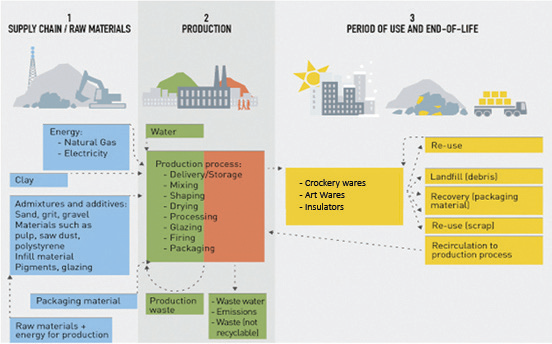
Himmatnagar
The United Nations Industrial Development Organization (UNIDO), in collaboration with the Bureau of Energy Efficiency (BEE), a statutory body under the Ministry of Power, Government of India, is executing a Global Environment Facility (GEF) funded national project titled 'Promoting energy efficiency and renewable energy in selected MSME clusters in India'. The project aims to develop and promote a market environment for introducing energy efficiency (EE) and enhanced use of renewable energy (RE) technologies in process applications in selected energy intensive industrial clusters, comprising micro, small and medium enterprises (MSMEs).


